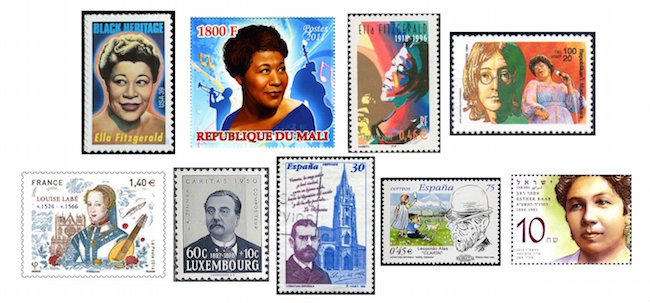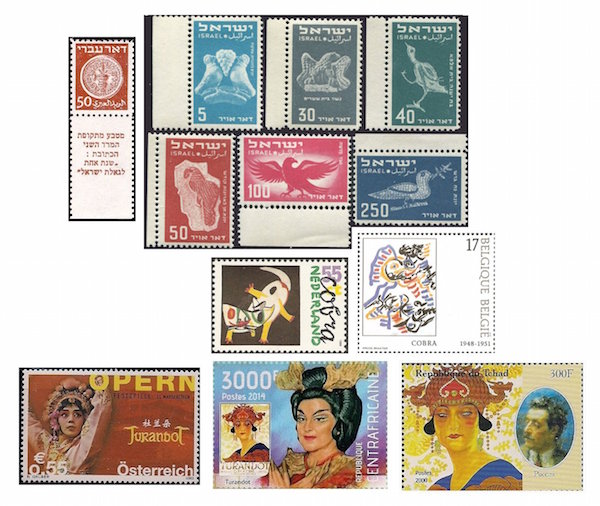The Arts on the Stamps of the World — April 25
An Arts Fuse regular feature: the arts on stamps of the world.

By Doug Briscoe
First Lady of Song Ella Fitzgerald is our First Lady of Stamps today, the one hundredth anniversary of her birth. We also celebrate two other women today: French Renaissance poet Louise Labé and Israeli poet Esther Raab, along with Luxembourgian composer Jean Antoine Zinnen, Spanish novelist Leopoldo Alas, Israeli graphic designer Otte Wallisch, and Dutch artist Karel Appel. No stamp for Walter de la Mare (25 April 1873 – 22 June 1956), alas.
The incomparable Ella Fitzgerald (April 25, 1917 – June 15, 1996) did very well in school and used to entertain the other kids on the way with her dancing. After her mother died from car accident injuries when Ella was 15, the girl went through a difficult period of declining grades and juvenile offenses, eventually spending some time in an orphanage and living on the streets. Her childhood performances stood her in good stead when she took to busking. In 1935 she joined Chick Webb’s orchestra, which, after his death four years later, was renamed Ella and her Famous Orchestra. During this time she also worked with Benny Goodman, and her career was well established. When she died at age 79, it was in her own Beverly Hills mansion. Between the lovely US and French stamps is, I think, an even lovelier design from Mali, with, at right, a Malagasy issue paying dual tribute to Ella and John Lennon. Ella fans take note: Harvard Radio, WHRB, will be broadcasting a three-day Ella Fitzgerald Orgy beginning on Monday May 10th and continuing for two days, each day from 5am to 1pm. For locals, try 95.3FM, for globals, whrb.org.

Another woman artist, but one from a very different time and place, is next. Louise Labé, born around 1520 in Lyon, France, died on this date in 1566. Her parents were not of the nobility, but her father had done very well in his trade as a ropemaker. (Louise would later be given the sobriquet La belle Cordière—the Beautiful Ropemaker). With a well-rounded education, she excelled at languages, horsemanship, and archery and enjoyed taking part in jousting (!) in men’s clothing. After her marriage she was hostess of a distinguished literary salon and began writing her own poetry, earning a reputation as a modern Sappho and the Tenth Muse. Alongside her verse, she wrote an early feminist piece urging women to take up the pen as she had done and an allegorical Debate Between Love and Folly that was translated into English by Robert Greene in 1584. In recent years it has been suggested that Labé actually wrote none of the works attributed to her, and that they were in fact written by some of the men of letters who frequented her salon. This challenge, though rejected by most Labé scholars, is supported by a number of others and has not yet been definitively refuted. The stamp is very new, from last year, the 450th anniversary of Labé’s death.
Jean Antoine Zinnen (25 April 1827 – 16 May 1898) is mostly recognized in his native Luxembourg as the composer of that country’s national anthem, but he also wrote two operettas, besides marches, cantatas, and songs.
Spanish novelist Leopoldo Alas (25 April 1852 – 13 June 1901), known by the pseudonym Clarín, is in some respects a typical case: studied for the law, began his writing as a journalist, took up teaching. His birthplace was Zamora. He worked in Madrid and Zaragoza before returning to Oviedo, the home of his childhood and youth. His magnum opus is the realist novel La Regenta, viewed by some critics as one of the finest novels of the 19th century. Alas’s other works include another novel, Su único hijo (1890), short stories, and articles.
It so happens that our next two subjects (in birth order) were both Israelis. The Hungarian grandfather of poet Esther Raab (April 25, 1894 – September 4, 1981) had settled in Palestine in 1876. Given that Esther was born there, she has been called “the first Sabra poet”, “Sabra” being a colloquial term originally used for any Jewish person born in Palestine under the Ottoman Empire or British Mandate. Now it applies to any Jew born on Israeli territory. Although denied further education by her father from the age of 15 and sent to live with relatives in Egypt, Raab was later able to attend the Sorbonne. Her first poems were published in 1922. Raab endured a series of tribulations in these times: difficulty bearing children because of an early bout of malaria, the stillbirth of a son in 1924, the unexpected early death of her husband in 1930, a short-lived second marriage, and financial troubles. All of this culminated in temporary cessations of her writing over the years. Given the cultural restrictions on women authors during her younger days, her work did not receive much recognition until she was awarded a prize for her second anthology in 1964.

Twelve years younger was Otto Welish (or Otte Wallisch; April 25, 1906 – May 15, 1977), a seminal graphic designer for the State of Israel. His hand created not only the calligraphy for the country’s Declaration of Independence, but many of its subsequent coins, banknotes, medals, and postage stamps. Guess which category I’m going to focus on here? Born in Moravia and educated in Vienna, Welish emigrated to Palestine in 1934. He was responsible for the new nation of Israel’s first stamps, which bear the legend Doar Ivri (“Hebrew mail”) because the official name of the new state had not yet been decided upon. These stamps depict ancient Jewish coins, and I give you one example. Welish also created the first Israeli air mail stamps—the complete set is shown—and others.
Dutch painter, sculptor, and poet Karel Appel (25 April 1921 – 3 May 2006) was born in Amsterdam and as a young man during the war went into hiding to avoid transportation to Germany to work in weapons manufacture. He had his first show in 1946, started sculpting the next year, and the year after that was one of the first members of the avant-garde movement CoBrA (Copenhagen, Brussels, Amsterdam) with Christian Dotremont and Asger Jorn. Their work was initially not well received, and Appel relocated to Paris, then New York and Florence. Decades later, the public having had ample chance to acclimate itself, Appel gave several successful shows in his native country. He died at his home in Zurich. We have two Appel stamps, Cobra Cat (1950) from the Netherlands and Black Writing Mixed With Colors (a collaboration with Dotremont) from Belgium.
Turandot was unfinished at the time of Puccini’s death in 1924 and was completed by Franco Alfano in 1926. The first performance was held at the Teatro alla Scala in Milan on this date exactly 91 years ago, 25 April, 1926, conducted by Arturo Toscanini. This performance included only Puccini’s music and not Alfano’s additions. The first performance of Alfano’s version was the following night, 26 April, although it is disputed whether the conductor was Toscanini again or Ettore Panizza. The colorful stamps are from Austria, the Central African Republic (with an uncredited Birgit Nilsson), and Chad.
A graduate of the University of Massachusetts with a B.A. in English, Doug Briscoe worked in Boston classical music radio, at WCRB, WGBH, and WBUR, for about 25 years, beginning in 1977. He has the curious distinction of having succeeded Robert J. Lurtsema twice, first as host of WGBH’s weekday morning classical music program in 1993, then as host of the weekend program when Robert J.’s health failed in 2000. Doug also wrote liner notes for several of the late Gunther Schuller’s GM Recordings releases as well as program notes for the Boston Classical Orchestra. For the past few years he’s been posting a Facebook “blog” of classical music on stamps of the world, which has now been expanded to encompass all the arts for The Arts Fuse.
